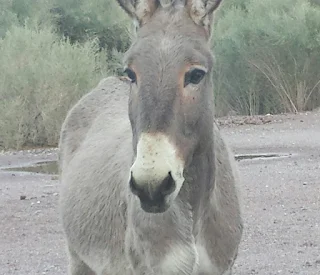 |
| Along the road less taken |
 |
| John's Polar Plunge Victory Pose |
First, John felt the need for a Polar Plunge wake-up. Exhilarating in 49 degree water temperatures. It seemed like a great idea until the fears of hypothermia started to set in. Well, at least John and his buddies were awake.
Next, as Laureen began to make preparations for our New Year feast, our buddy decided he wanted to go for a hike. Not relaxing, but a healthy way to start the year, so we were game. We even met some friends along the way -- not real talkative, but quite friendly.
 |
| A right down friendly gent |
It wasn't any time at all before we had worked up an appetite for that feast we'd been dreaming about and as usual, no one was disappointed.
Walking off dinner, we were struck by a most beautiful sunset. There had been a brief rain earlier in the day, unusual in this part of the country, and the residual cloud coverage had made for a remarkable coloring in the sky.
Watching the sunset, we noticed a "star" near the moon and the raucous debate began. Was it Mars? Venus? A satellite? The Russians? Laughter.
 |
| Hesperos and Eosphoros |
Unable to leave well-enough alone: the research began -- we are J and L RESEARCH and Exploration, after all, are we not?
So here it is: Eosphoros is Greek for dawn-bringer. As Astra Planeta, gods of the stars or planets, Eosphoros and his half-brother, Hesperos were paired with the planet the Greeks called Aphrodite.
Enter the Romans. Aphrodite becomes Venus. Hesperos becomes Vesper. You remember your vespers -- saying your evening prayers as Vesper (Venus), so close to the moon, is the evening star. But as times and tides shift, and the moon rises and sets with Venus in a different Earthly perspective, Venus becomes a sign of dawn and morning, rising with the moon. And Eosphoros becomes Lucifer. Yes, the dawn-bringer is the Morningstar.
Enter the Romans. Aphrodite becomes Venus. Hesperos becomes Vesper. You remember your vespers -- saying your evening prayers as Vesper (Venus), so close to the moon, is the evening star. But as times and tides shift, and the moon rises and sets with Venus in a different Earthly perspective, Venus becomes a sign of dawn and morning, rising with the moon. And Eosphoros becomes Lucifer. Yes, the dawn-bringer is the Morningstar.
 |
| Lucifer Morningstar - actor portrayal |
The Latin word lucifer means brilliant, bright or shining one, hence morning star or day star, even shining star through modern translations, rather than a reference to Satan. Even in the book of Revelation 22:16, Jesus is referred to as the morning star.
Appearing as a morning star, Venus, whose orbit lies between the Earth and the Sun, can be seen in the eastern morning sky for about an hour or so before the Sun rises and dims it. As an evening star, it appears in the western evening sky for about an hour or so after the sun sets before Venus itself, sets. At that point, it is the brightest object in the sky, after the sun and moon, outshining the giants Jupiter and Saturn. And herein enters the mythology once again. While Jupiter and Saturn rise high in sky, Venus never does. It shines so very brightly, striving for the highest place among the gods,but has been cast down?
Lucifer is the light-bearer, the light-bringer. How appropriate then that on the first day of the new year we were fortunate enough to capture with our eyes, this fallen star shining brightly, a reminder that we, too, though fallen, burdened by guilt, politics, debt, depression, whatever has ailed us in the past, may rise up in the new year and begin anew.






